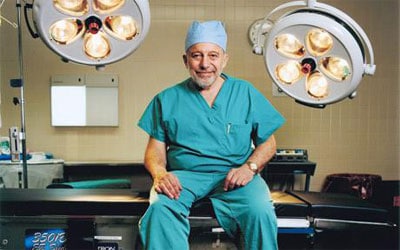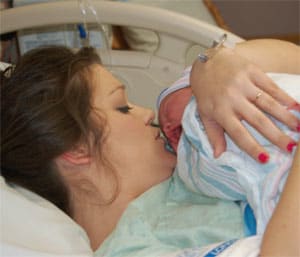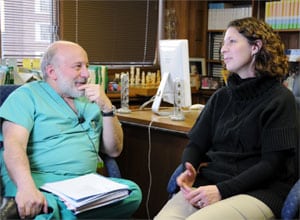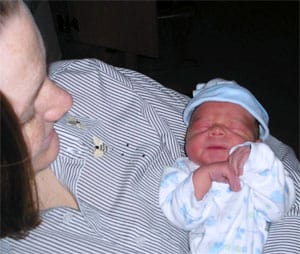By Victoria Lambert
The London Daily Telegraph Sunday Magazine, November 26, 2009

A small, warm-faced man, with sharp darting eyes and quickfire chatter, Dr Sherman Silber is used to breaking new ground. He has led and collaborated on research all over the world on techniques – ranging from sperm retrieval to embryo transfer and storage – that improve the chance of conception, and he was the first surgeon to transplant a testicle. His latest weapon in the war against infertility is his pioneering method of ovarian tissue freezing, a technique that could see women halting their biological clock and preserving their fertility for a later date.
“Patients come to see me from all over the world with the most complicated and tricky situations, the difficult cases that have failed elsewhere,” Dr Silber says at his clinic, the Infertility Center of St Louis, in Missouri. “But in essence they all want the same thing, a baby, so we sit them down, go through their history and work out what to do. We try to help – without letting them waste time or money on procedures that don’t work.”

Silber makes it sound straightforward. But the figures on infertility are stark: it is estimated that one in six couples worldwide are infertile – about 3.5 million in Britain. In some cases it is poor-quality or no sperm and in others tubal blockages or inability to ovulate. But Silber is sure the major reason for the epidemic increase in infertility is maternal age. “There is a worldwide infertility epidemic, and it’s due to women – understandably – putting off childbirth,” he says. “They’re waiting until their late thirties/early forties to have a family – and by then their fertility is seriously on the wane.”
Statistics show that in most of Europe, first-time mothers are on average 29 years old (up from 23 at the start of the 1970s). The pattern extends to the US, China and Japan. In Spain, the mean age of women at first childbirth has now even crossed the 30-year threshold.
Yet fertility drops dramatically and irreversibly with age, as our eggs age: at the age of 20, there is only a 2% incidence of infertility. By 30, there is a 20% incidence of infertility and age 40, more than 70% of women are infertile. In Britain, aside from pregnancy itself, infertility is the most common reason for women aged 20-45 to see their GP – with the National Institute for Clinical Excellence (Nice) defining infertility as failing to get pregnant after two years of regular unprotected sex.
“As doctors we have to find ways to help these women,” Silber says. “As human beings we have to decide how to tackle a society that has forced these women to delay motherhood to the point where many are missing out or have to turn to IVF with or without donor eggs to achieve their dream.”
It may sound surprising that an IVF specialist should be suggesting that we explore ways to create a world where no one needed IVF any more, but Silber’s views stem from an unconventional career. In the late 1960s Chicago-born Silber was stationed in Alaska treating Eskimos, Indians and Aleuts – “I learnt to do anything because there was no one else within miles to do it.” He became fascinated by microsurgery and proved to be a gifted practitioner. When he and his wife, Joan, moved to California in 1974, he was involved in kidney transplants, but soon discovered that, using microsurgical techniques and high magnification, he could tackle the trickiest reverse vasectomy, and this work quickly began to dominate his practice. By taking on cases that other surgeons thought hopeless, Silber was able to restore fertility to many male patients and their wives. (He has now performed more than 6,000 reverse vasectomies with a success rate of more than 95 per cent.)
When the Silbers moved to St Louis, Joan’s home city, in 1976, he joined St Luke’s Hospital to practice urology, but requests for help with infertility overwhelmed him. Along with Lord (Robert) Winston and Prof Victor Gomel, he was among the pioneers of new microsurgical methods to reverse tubal ligation – the operation in which a woman’s fallopian tubes are severed and ‘tied’ as a form of permanent contraception. In 1979, by which time he was working only in infertility, Silber performed an entire testicle transplant between twin brothers, which led to five successful natural pregnancies in the recipient’s wife.
At his clinic in St Luke’s, Silber works alongside two colleagues, Dr Jorge Pineda and Dr Michael DeRosa. The St Luke’s team began offering IVF shortly after the first successful IVF baby, Louise Brown, was born in 1978. Working with a team at Brussels University in Belgium, they went on to develop intracytoplasmic sperm injection (ICSI), where a single sperm (however poor the overall batch) is identified as the best candidate and microscopically injected into an egg [technical video]. This technique, which they were the first to use, helps those men whose sperm previously were too weak or too few to fertilize in vitro. Silber claims fertilization results per egg using ICSI of about 70 per cent, a fertilization rate per infertile couple of more than 99 per cent if the female partner has adequate eggs, and a pregnancy rate per treatment cycle of more than 50 per cent.
Last month I spent three days with Silber, watching him consult with patients and then operate on them, or perform egg retrieval or embryo transfer. Dressed in slightly shabby-looking scrubs, his only status-indicator a heavy gold watch given to him as a present by a Saudi prince 15 years ago, Silber, 67, does not dispense false hope, spending as long as each patient needs, particularly when interpreting the black-and-white photographs of embryos that are used to determine which one has the best chance of implantation and development. Later he tells me, “It’s important that the women stay relaxed at the time of embryo transfer. There is research that shows overly anxious patients do have a lower pregnancy rate.”
His unconventional but cheerful approach is coupled with a serious drive. The clinic is open seven days a week; Silber works 80-100 hours a week, seeing 40-50 patients. His ferocious work ethic is perhaps due in part to his mother. Growing up in the impoverished South Side of Chicago, Shirley – aware of her own lack of formal education – refused to countenance her son’s interest in becoming an academic. “We have professors living on the South Side,” she told him, “but doctors don’t live here. You’re going to medical school.”

When Stephanie Yarber, a 24-year-old bank worker from Alabama, called Dr Silber in 2004 to ask if he thought an ovary transplant was “a crazy idea”, he leapt at the challenge. “I told her, I’ve been waiting for your call for 30 years!’ he says. ‘At heart I was and am a transplanter, so all these years I’d been considering the possibility.”
Yarber had entered the menopause at 14 – her ovaries had simply switched off, because she was born with just a minuscule supply of eggs, and ran out of them at a very young age. This hadn’t happened to her twin sister, Melanie Morgan. The pair had always agreed that when Stephanie wanted to start a family, Melanie would simply donate some eggs. But three attempts, using the eggs in IVF, failed, and Stephanie was, as she told Silber, “plumb out of money”. There was no problem with the donor: Melanie conceived her own children easily, and had three by the age of 24.
So Yarber began researching on the internet, and learnt of Silber’s testicle transplants. She also learnt that his clinic stored sperm and eggs for young cancer patients whose future fertility could be compromised by chemotherapy and radiotherapy. And since 1996, in cases where treatment was so urgent that there was not time for female patients to go through several IVF cycles to produce enough mature eggs for freezing, Silber had been experimenting with freezing ovarian tissue instead, believing it could be re-grafted into the body when a patient had sufficiently recovered to want to start a family. The treatment carried no side effects, and as some ovarian tissue remained behind, there was no loss of fertility or signs of early menopause, although Silber found that women would begin their menopause about two years earlier than they otherwise would, so at 48 or 49, not 51 (the average menopause age).
Combining all this knowledge seemed the logical step, and, in April 2004, a slender strip of Melanie’s ovarian tissue was transplanted into Stephanie. “It was a standard microsurgical approach,” Silber explains. “First we removed Melanie’s ovary. All of a woman’s eggs are situated on the outside edge of her ovary – in the cortex or shell – so we simply had to scoop out the inside, leaving us with strips of “shell” which contained immature eggs. Then we took that, and placed it on to one of Stephanie’s ovaries just like a skin graft and sutured the two tightly together.”
This is where Silber’s talents in microsurgery are so vital: he operates looking through very high-magnification microscopes, which also relay film of the procedure to a television screen so that the rest of the surgical team can observe. With incredible finesse, he uses microsutures, held in specially adapted surgical needles, so tiny that they are barely visible to the naked eye.
Eighty days after surgery, Yarber had her first period in 10 years. A month later she was pregnant with a little girl, Anna, who would be born in June 2005. “It seemed like a wild thing to do,” Silber says, “but after 40 years of animal research, transplanting all types of organs, it worked exactly as we expected. I was really thrilled.” Yarber has since had another daughter and is currently pregnant for the third time. All her conceptions were natural.
Of course, monozygotic or identical twin-to-twin ovarian transplant, while potentially carrying the best possible rate of success owing to the very low chance of rejection thanks to identical DNA, will always remain an acutely rare niche in fertility medicine. Since Stephanie Yarber’s transplant, Silber has transplanted ovarian tissue in nine sets of twins, and, for the first time, in 2007 transplanted a whole ovary into Susanne Butscher from her identical twin, resulting in the birth of her daughter, Maja. “There have been 14 pregnancies and ten babies in all from these cases,” Silber says. “That’s a robust success rate.”
The techniques Silber used for this practice have also worked with his cancer patients, who are now coming forward to reclaim their frozen tissue. In 1998 Missouri-born Amy Tucker, then 18 and suffering from Hodgkin’s lymphoma, was due to have a bone marrow transplant. “It was all a bit of a whirlwind,” she says, “but a nurse asked if I wanted to try storing ovarian tissue. I had nothing to lose; I’d even had a bout of chemotherapy already and that could have damaged my ovary irreversibly, but the radiotherapy I needed now would guarantee my sterility.”

Tucker met Silber and they decided he should remove one whole ovary (the right) [technical video] and freeze it [news video]. He left the other in situ, just in case it could work naturally. “With cancer patients, it is hard to quantify possible results as there are so many other biological factors resulting from the disease and the treatment,” Silber says.
The bone marrow transplant worked initially and Tucker’s cancer went into remission for two years. Then it recurred in December 2000 and she went back for more chemotherapy. “Any thoughts or worries about my ovary were completely lost in everything else that was happening,” she says.
But after Tucker had recovered, in 2005, she began dating her future husband, Jason, an old schoolfriend, and her thoughts began to turn to children. She comes from a tradition of large families: her mother had nine siblings, her father 14. And in January this year, the couple, now both 32 and living in Columbia, Illinois, decided to have the ovarian tissue transplanted back.
She told Silber at the time, “I am so grateful that I had cancer. If I had not had cancer, I would never have had my ovary frozen. Now my friends in their thirties are all worried about their biological clock but I will have a 19-year-old’s ovary.”
Before Silber could go ahead, the tissue had to be checked for traces of cancer, of which it was free, and then three slivers were attached to Tucker’s left ovary. “I was aware that it might result in the return of my periods, and nothing else,” she says. “And we weren’t even sure how long that would take. But by last June I had a period. And then in September I had a positive pregnancy test.”
She adds, “I had hoped that it would work, but I had no high expectations and was prepared to adopt instead. I hoped and prayed. And now – well, I am breathless. This really is a miracle. Actually, I’m still in shock.”
Days begin at 4am at Silber’s clinic. The team of embryologists that fill the lab may be knee-deep in steaming flasks of nitrogen (where sperm, eggs, embryos and tissue are stored), but the high tech facilities themselves with the most modern and specialized air quality equipment and remote nitrogen generators are surprisingly friendly and pleasant, and on the walls are pictures of beaming parents and adored babies, sent in with grateful thanks.
The hi-tech equipment is kept in a row of white cupboards that could be in someone’s kitchen, but the security is as good as any Swiss bank. During my visit, news comes of a mix-up in another unconnected clinic, where the egg was transferred into the wrong mother during an IVF procedure. “Unthinkable,” Silber snaps. “It simply shouldn’t happen ever. There’s no excuse.”
Everything here is color-coded, labeled in triplicate, and watched over with careful precision. There are sensors for when fridges are left open too long, or for fractional changes in temperature. A new air-conditioning system will soon be installed to ensure the air that surrounds the embryos is absolutely pure. “We can’t risk anything,” Silber says.
His operating team includes Dr DeRosa and Dr Pineda – both gynecologists. Patients are shared equally between the three and all perform IVF procedures, but Silber watches over all. The lab team is small, close-knit and friendly. Despite their efficiency and necessary precision (not to mention very steady hands: they are responsible for injecting a single sperm into an egg, using high magnification equipment), they bring welcome humanity to what might be a cold, clinical environment.
Despite Silber’s reticence to list numbers, the clinic’s website claims a pregnancy rate of more than 50 per cent per attempt. (In Britain the average success rate for IVF treatment using non-donor fresh eggs is 31 per cent for women under 35.) The St Louis clinic’s figure is regardless of diagnosis or age, including the most difficult cases such as one where the male partner’s sperm had to be retrieved internally under general anesthetic, and the female partner had poor-quality eggs and an unusually shaped cervix so the embryos could be transplanted only by inserting them through an incision.
The clinic’s high success rate is dependent not only on the high-magnification instruments that allow the embryologists to painstakingly extract one sperm from a batch and inject it into the heart of an egg. It is also due to the adoption of a freezing technique, pioneered by Dr Masashige Kuwayama from the Kato Clinic in Tokyo, called vitrification. Vitrification uses a super-high concentration of antifreeze, and drops the temperature so rapidly – at 23,000C per minute – that the water inside cells instantaneously super-cools into a solid, with no ice crystal formation. In the conventional slow-freezing technique, the temperature is brought down at 0.3C per minute, and there is always some intra-cellular ice crystal formation, which can damage embryos, and in most cases eggs. With vitrification Silber’s team say they can freeze and thaw, and even refreeze and rethaw, with impunity.
The impact of this will affect any woman whose fertility is an issue – not only those with cancer or non-functioning ovaries. Before vitrification, frozen eggs were seen as a bit of a gamble; it is possible, but the results are not reliable. “Egg freezing is still a very new and experimental technique. To date around 900 babies have been born using frozen eggs worldwide. Only five babies have been born in the UK using frozen eggs [compared with thousands born from frozen embryos],” says a spokesman for the Human Fertilization and Embryology Authority (HFEA), Britain’s governing body for this area. Silber views this as a very outdated point of view.
“Embryos survive freezing better than eggs because they are more stable,” Kathy Lenahan, the head embryologist at the St Louis clinic, says. Ovarian tissue – with its hundreds of thousands of immature eggs – freezes much more easily than individual eggs.
According to the HFEA, only two clinics in Britain store ovarian tissue: the Center for Reproductive Medicine based at Barts Hospital in London, and a private clinic, Care Manchester. Any clinic wishing to do so needs a license from the HFEA and one from the Human Tissue Authority. An HFEA spokesman confirms that in Britain tissue storage is “done for medical reasons: a young woman undergoing cancer treatment which may damage her ovaries might opt to have ovarian tissue stored prior to her treatment rather than going for egg stimulation and collection because the hormones involved may affect her illness.” But they are not aware of anyone undertaking tissue storage for any other reason, and no clinic offers that service in Britain. There have been no reported cases of re-transplantation of this stored tissue in Britain yet, either.
Apart from Silber’s clinic, the only other place in the world where tissue is stored for non-cancer patients, is the University of Amsterdam. Silber believes there are two real advantages to freezing the ovary rather than a single egg. The process of removing the tissue is much faster and less painful than going through IVF. He compares it to any other type of keyhole abdominal surgery – say, an appendectomy. “It may cause some pain for a week that perhaps needs painkillers, but recovery should be fast and uncomplicated,” he explains. And afterwards, when it is working and is releasing eggs on a monthly basis – just like a naturally functioning ovary – the recipient ought to be able to get pregnant as easily as anyone else.
Compare that with the months of hormone drugs required to stimulate the body for IVF, the risks of hyper-stimulation (which can cause pain, swelling, cysts, shortness of breath and even kidney failure), the procedures to remove the eggs from the ovarian follicles and then transfer the embryos back in.
The emotional cost can be as heavy as the physical, and both can be dwarfed by the financial cost. Silber compares a bill of $8,000 for ovarian tissue transfer (covering both extraction and replantation) with $35,000-$50,000 for 3 cycles of IVF. Storage for eggs, embryos, sperm or ovarian tissue is similar: about $150 a year.
If ovarian tissue retrieval [news video], storage by vitrification and transfer proves to be reliable, will it become the method of choice for fertility doctors everywhere? And, if so, does it also bring the intriguing possibility that women will be able to truly put their fertility on ice when young – knowing that they can return to it when they are older and ready to start a family – without ever needing to resort to IVF?

Amy Johnson, a 37-year-old former entrepreneur & computer consultant who lives in Chicago with her husband, Marc, a chemist, may be one of the first true fertility pioneers. She came across Dr Silber five years ago when a friend was struggling to conceive a second child. “Western society heavily encourages women to delay motherhood, and we’re bombarded with stories of women who have had babies in their late thirties and forties – but not told that these pregnancies are often thanks to eggs donated from younger women,” she says. “It is so frustrating.”
At the time, Johnson was not ready to start a family, but realized she did not want to rely on IVF later on – she disliked the thought of the drugs and was realistic about the chances. “I did a whole lot of research on the net, and found Dr Silber. Ovarian tissue storage sounded like an option. His procedure didn’t have as much data as egg freezing but I still thought it was a better bet.”
She had ovarian tissue removed in July 2006 and she then became pregnant naturally in September (resulting in baby Magnus, now two). But the frozen tissue will allow her to have more babies naturally in the future, even when she is over 40 years old.
“The process really focused our minds, and we just didn’t want to miss out on having children,” she says. “I see the operation as insurance. I sleep better at nights knowing that if I have trouble getting pregnant again thanks to my age, I can get the tissue replaced, and I’ve turned back the clock.”
She hopes telling her story now will encourage other women to think ahead; “maybe someone in their twenties who is not in a relationship, and had a career or is in the military, may read about me, decide to follow suit, and save themselves from heartache later.”
Johnson is $5,000 poorer but immeasurably richer in confidence. “Things happen, you never know what is round the corner,” she says. “We’ve frozen some sperm too, in case.”
While she acknowledges that such surgery is at best a technical answer to a societal problem, others see it as a step too far. In Britain, Dr Gillian Lockwood, the medical director of the independent Midlands Fertility Clinic and vice-chairman of the Royal College of Obstetricians and Gynecologists ethics committee, is no stranger to the idea of preserving fertility. She says, “There is no doubt at all with cancer patients that storing a sliver of ovarian cortex is a good idea. It has to be better than nothing. But to suggest that women in their twenties – who may or may not have met Mr Right and be planning on having a family in the traditional way – will start opting for storing their ovaries and keeping them on ice until they are in their late thirties is fundamentally misguided.”
“That is just old dinosaur-type thinking” is Silber’s response. “Let’s be clear. Disdain for the woman who has not found Mr Right in her twenties is just a socially ignorant statement. You can lecture or moralize to them that they should get married young and have children early like their grandparents did, but modern women do not accept that condescending, patronizing view. In fact they very much resent it.”
“Based on what we’re seeing, we recommend ovarian tissue storage for the extension of fertility. Yes, it does throw up ethical dilemmas; the possibility of older women having babies. Personally I wouldn’t want to treat a 60-year-old woman, but what if she is in incredible health and her husband is 35? Our whole lifestyle is healthier, better care is available. Eighty is the new 60.”
Moreover, he says, “The women who come to us are not fools. They are bright, well-educated thirtysomething women who have weighed up the odds and decided this is their best option. I have lawyers, doctors, entrepreneurs, academics. Some don’t intend to rely on it entirely, they see it as their ‘ace in the hole’ for a bigger family. And there are those such as orthodox Jews who due to their faith who would not be able to accept egg donation.”
Silber clearly sees ovarian tissue storage as potentially a way to help all women. “While we need population growth for a vibrant economy, what we have is population decline. Some countries such as Israel and Belgium are dealing with this by covering the cost of IVF. But by and large, in most countries, neither insurance companies nor the government will cover it.”
In Britain NICE officially recommends to primary care trusts that couples in which the woman is aged 23-39 years at the time of treatment and who have an identified cause for their fertility problems (such as blocked tubes) or who have infertility of at least three years’ duration should be offered up to three stimulated cycles of IVF treatment on the NHS.
Where the doctors agree is that society needs to decide how it will solve the conundrum. “Why have we made it so difficult for women to fit natural reproduction into their lives?” Dr Lockwood asks. “Let’s not encourage women to freeze eggs so they can have babies later. Let’s make it easier for them to have them at an earlier, natural age.”
Dr Silber believes there are only two ways that our international fertility crisis will be solved. Either respective governments must fund IVF more freely, or women in their early twenties should be counseled and offered a state-sponsored procedure to remove ovarian tissue for storage until they have finished their education, established their careers, found a partner, bought a home and are finally ready to begin a family.
It is a proposal that Silber put to Hillary Clinton, the US Secretary of State, when he met her following the election of President Obama, for whom he campaigned.
“I told her about my work in infertility and the seriousness of the situation,” Silber tells me. “When I explained it was due to delaying motherhood, she asked me what I was doing to counter the problem. So I told her about ovary freezing and how we had perfected it for cancer patients but could now offer this to non-cancer patients as well to protect their biological clock. She said to me, ‘Well, why don’t you do this?'”
“I told her, ‘Well, it is ethically open to debate and discussion.’ She then answered, ‘Well, I think it is a no-brainer.'”
“And she’s right. Why in the world would you deny this to women?”




